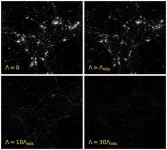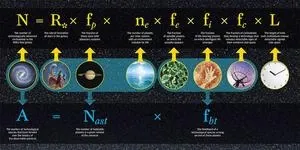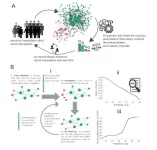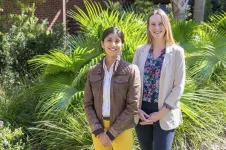(Press-News.org) The chances of intelligent life emerging in our Universe – and in any hypothetical ones beyond it – can be estimated by a new theoretical model which has echoes of the famous Drake Equation.
This was the formula that American astronomer Dr Frank Drake came up with in the 1960s to calculate the number of detectable extraterrestrial civilisations in our Milky Way galaxy.
More than 60 years on, astrophysicists led by Durham University have produced a different model which instead focuses on the conditions created by the acceleration of the Universe's expansion and the amount of stars formed.
It is thought this expansion is being driven by a mysterious force called dark energy that makes up more than two thirds of the Universe.
What is the calculation?
Since stars are a precondition for the emergence of life as we know it, the model could therefore be used to estimate the probability of generating intelligent life in our Universe, and in a multiverse scenario of hypothetical different universes.
The new research does not attempt to calculate the absolute number of observers (i.e. intelligent life) in the universe but instead considers the relative probability of a randomly chosen observer inhabiting a universe with particular properties.
It concludes that a typical observer would expect to experience a substantially larger density of dark energy than is seen in our own Universe – suggesting the ingredients it possesses make it a rare and unusual case in the multiverse.
The approach presented in the paper involves calculating the fraction of ordinary matter converted into stars over the entire history of the Universe, for different dark energy densities.
The model predicts this fraction would be approximately 27 per cent in a universe that is most efficient at forming stars, compared to 23 per cent in our own Universe.
This means we don't live in the hypothetical universe with the highest odds of forming intelligent life forms. Or in other words, the value of dark energy density we observe in our Universe is not the one that would maximise the chances of life, according to the model.
Dark energy's impact on our existence
Lead researcher Dr Daniele Sorini, of Durham University's Institute for Computational Cosmology, said: "Understanding dark energy and the impact on our Universe is one of the biggest challenges in cosmology and fundamental physics.
"The parameters that govern our Universe, including the density of dark energy, could explain our own existence.
"Surprisingly, though, we found that even a significantly higher dark energy density would still be compatible with life, suggesting we may not live in the most likely of universes."
The new model could allow scientists to understand the effects of differing densities of dark energy on the formation of structures in the Universe and the conditions for life to develop in the cosmos.
Dark energy makes the Universe expand faster, balancing gravity's pull and creating a universe where both expansion and structure formation are possible.
However, for life to develop, there would need to be regions where matter can clump together to form stars and planets, and it would need to remain stable for billions of years to allow life to evolve.
Crucially, the research suggests that the astrophysics of star formation and the evolution of the large-scale structure of the Universe combine in a subtle way to determine the optimal value of the dark energy density needed for the generation of intelligent life.
Professor Lucas Lombriser, Université de Genève and co-author of the study, added: "It will be exciting to employ the model to explore the emergence of life across different universes and see whether some fundamental questions we ask ourselves about our own Universe must be reinterpreted."
Drake Equation explained
Dr Drake's equation was more of a guide for scientists on how to go about searching for life, rather than an estimating tool or serious attempt to determine an accurate result.
Its parameters included the rate of yearly star formation in the Milky Way, the fraction of stars with planets orbiting them and the number of worlds that could potentially support life.
By comparison, the new model connects the rate of yearly star formation in the Universe with its fundamental ingredients, such as the aforementioned dark energy density.
The study, which was funded by the European Research Council and also involved scientists at the University of Edinburgh and the Université de Genève, has been published today in Monthly Notices of the Royal Astronomical Society.
Media contacts
Sam Tonkin
Royal Astronomical Society
Mob: +44 (0)7802 877 700
press@ras.ac.uk
Dr Robert Massey
Royal Astronomical Society
Mob: +44 (0)7802 877 699
press@ras.ac.uk
Scientific contacts
Dr Daniele Sorini is available for interview on 11 and 12 November and can be contacted via daniele.sorini@durham.ac.uk
Alternatively, please contact Durham University Communications Team to arrange on communications.team@durham.ac.uk
Images and captions
Stars in universes of different dark energy densities
Caption: How the same region of the Universe would look in terms of the amount of stars for different values of the dark energy density. Clockwise, from top left, no dark energy, same dark energy density as in our Universe, 30 and 10 times the dark energy density in our Universe. The images are generated from a suite of cosmological simulations.
Credit: Oscar Veenema
Note: The simulations were run on the Cosma@DiRAC supercomputer in Durham as part of the EAGLE project (J. Schaye et al., 2015, Monthly Notices of the Royal Astronomical society, Vol. 446, p. 521), and were first presented by L. A. Barnes et al. (2018) in Monthly Notices of the Royal Astronomical Society, Vol. 477, p. 3727.
A triple-star system
Caption: This Hubble Space Telescope image captures a triple-star system, which can host potentially-habitable planets. Our nearest stellar neighbour, the Alpha Centauri system, includes three stars.
Credit: NASA, ESA, G. Duchene (Universite de Grenoble I); Image Processing: Gladys Kober (NASA/Catholic University of America)
Drake Equation (revised)
Caption: The Drake Equation, a mathematical formula for the probability of finding life or advanced civilisations in the Universe, as revised by two University of Rochester researchers in 2016.
Credit: University of Rochester
Further information
The paper ‘The impact of the cosmological constant on past and future star formation’, by Daniele Sorini, John A. Peacock and Lucas Lombriser, will be published in Monthly Notices of the Royal Astronomical Society. DOI: 10.1093/mnras/stae2236. The link will go live when the embargo lifts. To view a copy of the study before this, email press@ras.ac.uk
The Drake Equation's parameters in full are:
R* = the rate of yearly star formation in the Galaxy
fp= the fraction of stars with planets orbiting them
fg= the fraction of stars that could support habitable planets
ne = the number of planets that can potentially support life (per star with planets)
fl = the fraction of planets that actually develop life at some point
fc= the fraction of civilisations that emit detectable signs of their presence
Notes for editors
About the Royal Astronomical Society
The Royal Astronomical Society (RAS), founded in 1820, encourages and promotes the study of astronomy, solar-system science, geophysics and closely related branches of science.
The RAS organises scientific meetings, publishes international research and review journals, recognises outstanding achievements by the award of medals and prizes, maintains an extensive library, supports education through grants and outreach activities and represents UK astronomy nationally and internationally. Its more than 4,000 members (Fellows), a third based overseas, include scientific researchers in universities, observatories and laboratories as well as historians of astronomy and others.
The RAS accepts papers for its journals based on the principle of peer review, in which fellow experts on the editorial boards accept the paper as worth considering. The Society issues press releases based on a similar principle, but the organisations and scientists concerned have overall responsibility for their content.
Keep up with the RAS on X, Facebook, LinkedIn and YouTube.
About Durham University
Durham University is a globally outstanding centre of teaching and research based in historic Durham City in the UK. We are a collegiate university committed to inspiring our people to do outstanding things at Durham and in the world.
We conduct research that improves lives globally and we are ranked as a world top 100 university with an international reputation in research and education (QS World University Rankings 2024).
We are a member of the Russell Group of leading research-intensive UK universities and we are consistently ranked as a top 10 university in national league tables (Times and Sunday Times Good University Guide, Guardian University Guide and The Complete University Guide).
For more information about Durham University visit: www.durham.ac.uk/about/
END
A formula for life? New model calculates chances of intelligent beings in our Universe and beyond
2024-11-13
ELSE PRESS RELEASES FROM THIS DATE:
Could a genetic flaw be the key to stopping people craving sugary treats?
2024-11-13
The work provides novel genetic insights into dietary preferences and opens the possibility of targeting SI to selectively reduce sucrose intake at the population level.
The study was led by Dr. Peter Aldiss, now a group leader in the School of Medicine at the University of Nottingham, alongside Assistant Professor Mette K Andersen, at the Novo Nordisk Foundation Centre for Basic Metabolic Research in Copenhagen and Professor Mauro D’Amato at CIC bioGUNE in Spain and LUM University in Italy. It also involves scientists internationally from Copenhagen, Greenland, Italy and Spain as part of the ‘Sucrase-isomaltase working group’.
Dr Aldiss said: “Excess ...
Experts urge complex systems approach to assess A.I. risks
2024-11-13
[Vienna, November 13, 2024] — With artificial intelligence increasingly permeating every aspect of our lives, experts are becoming more and more concerned about its dangers. In some cases, the risks are pressing, in others they won't emerge until many months or even years from now. Scientists point out in The Royal Society’s journal that a coherent approach to understanding these threats is still elusive. They call for a complex systems perspective to better assess and mitigate these risks, particularly in light of long-term uncertainties and complex interactions between A.I. and society.
"Understanding the risks of A.I. requires recognizing the intricate interplay ...
Fossil fuel CO2 emissions increase again in 2024
2024-11-13
Global carbon emissions from fossil fuels have reached a record high in 2024, according to new research by the Global Carbon Project science team.
The 2024 Global Carbon Budget projects fossil carbon dioxide (CO 2) emissions of 37.4 billion tonnes, up 0.8% from 2023.
Despite the urgent need to cut emissions to slow climate change, the researchers say there is still “no sign” that the world has reached a peak in fossil CO2 emissions.
With projected emissions from land-use change (such as deforestation) of 4.2 billion tonnes, total CO2 emissions are projected to be 41.6 billion tonnes in 2024, up from 40.6 billion tonnes last year.
Over the last 10 years, fossil ...
Winners of Applied Microbiology International Horizon Awards 2024 announced
2024-11-13
The winners of the Applied Microbiology International Horizon Awards 2024 have been announced.
The prizes, awarded by the learned society Applied Microbiology International (AMI), celebrate the brightest minds in the field and promote the research, group, projects, products and individuals who continue to help shape the future of applied microbiology.
The One Health Microbiome Center at Penn State has been named as this year’s winner of the WH Pierce Global Impact in Microbiology Prize 2024.
This award acknowledges and celebrates individuals, teams, or organisations that have made groundbreaking contributions to global challenges through applied microbiology.
The One Health Microbiome ...
A toolkit for unraveling the links between intimate partner violence, trauma and substance misuse
2024-11-12
The opioid crisis has left an estimated 2.5 million people 18 and older in the U.S. with opioid use disorder, or OUD. Despite increased attention to the heavy toll taken by OUD, key risk factors such as intimate partner violence (IPV) and post-traumatic stress disorder (PTSD) are often overlooked. Both increase the risk of OUD and complicate recovery efforts.
A team of MUSC researchers led by clinical psychologists Amber Jarnecke, Ph.D., and Tanya Saraiya, Ph.D., both of the Department of Psychiatry and Behavioral ...
Can everyday physical activity improve cognitive health in middle age?
2024-11-12
HERSHEY, Pa — Exercise has been shown to improve brain health and reduce the risk of cognitive decline and dementia over the long-term. But engaging in everyday physical activity has immediate benefits for brain health, according to a new study from researchers in the Penn State College of Medicine.
The team found that middle-aged people who participated in everyday movement showed improvement in cognitive processing speed equivalent to being four years younger, regardless of whether the activity was lower intensity, like walking the dog or doing household chores, or higher intensity, like jogging.
The findings were published ...
Updated guidance reaffirms CPR with breaths essential for cardiac arrest following drowning
2024-11-12
Updated Guideline Highlights:
The American Heart Association and the American Academy of Pediatrics update recommendations for untrained lay rescuers and trained rescuers resuscitating adults and children who have drowned.
One important update is the recommendation to provide cardiopulmonary resuscitation (CPR) with rescue breaths and chest compressions to all persons in cardiac arrest following drowning after removal from the water.
The updated recommendations for resuscitation following drowning are, for the first time, well codified, accompanied ...
Study reveals medical boards rarely discipline physician misinformation
2024-11-12
Despite increased concerns about doctors spreading false medical claims during the COVID-19 pandemic, medical boards rarely take disciplinary action against physicians for spreading misinformation, according to a new study by Richard S. Saver, Arch T. Allen Distinguished Professor of Law at the University of North Carolina School of Law and Professor in the Department of Social Medicine at the UNC School of Medicine, published in JAMA Network Open.
Through analysis of over 3,100 medical board disciplinary proceedings across the nation’s five most populous states, Saver found that spreading misinformation to the public was the least common reason for ...
New treatment helps children with rare spinal condition regain ability to walk
2024-11-12
BALTIMORE, November 12, 2024— Researchers at Kennedy Krieger Institute’s International Center for Spinal Cord Injury (ICSCI) have made a remarkable advancement in treating children with Acute Flaccid Myelitis (AFM), a rare but severe neurological condition that causes sudden paralysis.
A new study, published in the journal Children, demonstrates that a combination of Transcutaneous Spinal Cord Stimulation (TSS) and movement training can help children with AFM improve their ability to walk. TSS is a non-invasive therapy ...
'Grow Your Own' teacher prep pipeline at the University of Louisiana at Lafayette funded by US Department of Education
2024-11-12
A new teacher prep initiative from the University of Louisiana at Lafayette’s College of Education & Human Development received a $3.1 million grant from the U.S. Department of Education’s Teacher Quality Partnership grant program to establish and strengthen a Grow Your Own Network across Acadiana.
This initiative, designed to address teacher shortages in the south-central region of Louisiana, will build a regional network connecting local school districts with higher education institutions ...






